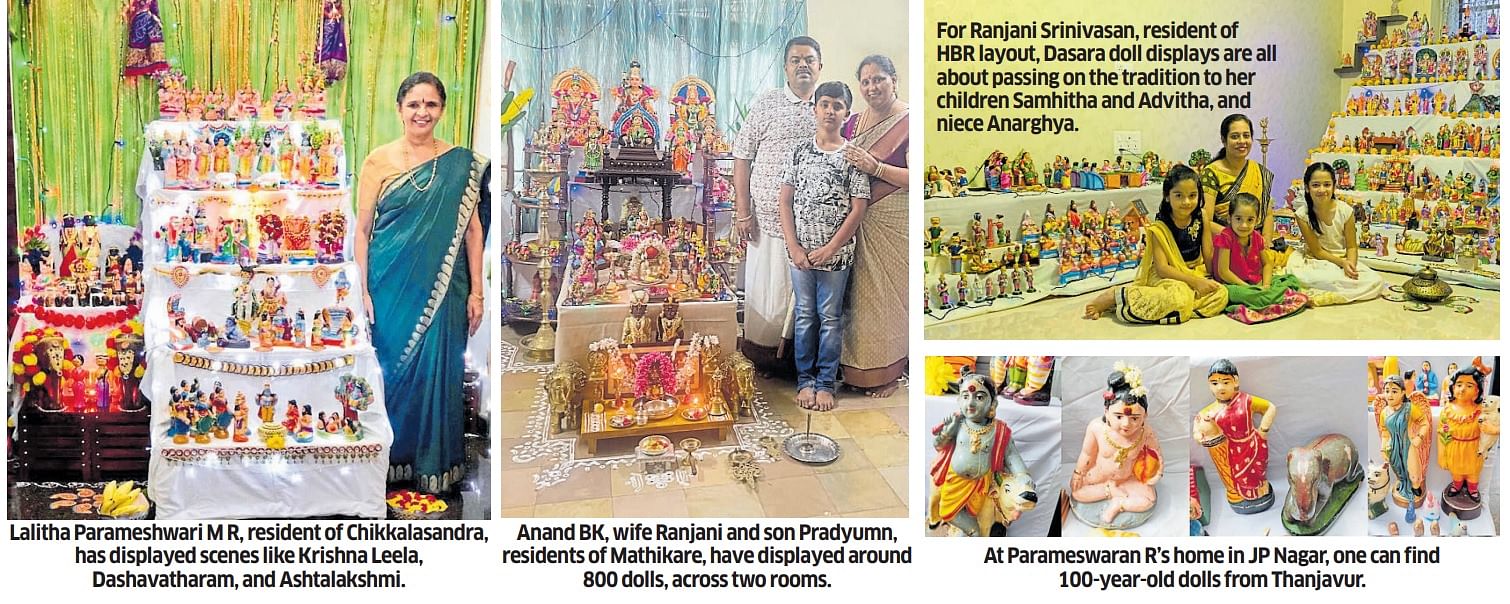
Bengaluru homes are ringing in the Dasara festivities with colourful doll displays. The displays include 100-year-old dolls to life-size figurines.
Visitors are streaming in and out of many of these homes and some are leaving with goodie bags on their way out.
Veena Ravi, vice-principal of CB Bhandari Jain College, and resident of Gandhi Bazaar, Basavanagudi, owns more than 5,000 dolls.
“This year, we have displayed only 2,500 dolls across two floors as we were not sure if people would want to visit now. This season, we are depicting Andal’s stories in the display. Our collection includes dolls that are more than 60 years old that have been passed on by my mother,” she says.
Dolls of Vishnu with his consorts, similar to what is displayed at the Srirangam Temple, Krishna and his wife, Kali, stories from the Ramayana, and huge dolls of Shiva and Parvathi seated together are part of the collection.
Her own doll collection includes clay, papier mache, wooden and porcelain dolls and is sourced from Tamil Nadu, Mathura, Maharashtra, and across the country.
Likewise, Lalitha Parameshwari M R, resident of Chikkalasandra, has only displayed a part of her doll collection.
“Scenes like Krishna Leela, Dashavatharam, Ashtalakshmi, Mysuru Dasara procession, life in a village, and children at play are displayed,” she says.
Every year, she adds a few sets to her collection. “My grandmother used to love setting up the displays, passed on by generations,” she says.
Passing on tradition
For Ranjani Srinivasan, an HR professional and resident of HBR layout, Dasara doll displays are all about passing on the tradition to her children Samhitha and Advitha, and niece Anarghya.
“This year’s theme is Mahavishnu. I have dolls of him on the Garuda vahana, Dashavataram, Tirupathi Brahmotsavam (which is also happening now), Alwar dolls who sang in praise of the lord, among others. I also bought a 18-doll sithar set this season, which symbolises attainment of self-realisation. My dolls are sourced from across India, from Malleswaram in the city to Kolkata, Krishnagiri, and Madurai,” she says.
100-year-old dolls
Parameswaran R, wife Sireesha and son Avaneesh, residents of JP Nagar, have displayed dolls on a setup comprising seven steps.
“Our collection includes 100-year-old dolls from Thanjavur, which were gifted to my grandmother by her brother. Dasavatharam that speaks about Lord Vishnu and is also related to human evolution, Vaikuntam dolls, Ashtalakshmi, Lord Venkateswara and Padmavathi dolls are other highlights of our collection,” says Parameswaran.
Marriage sets that talk about family and human relationships and ones showcasing different trades are also on showcase.
Goodie bags for visitors
Anand BK, resident of Sundarnagar, Gokula Extension, Mathikare, has around 800 dolls on display. His collection started almost 30 years ago and is spread out across two rooms of his house today.
“Dolls on Durga, avatars of Vishnu and traditional toys dominate the collection. We also have some wooden toys,” he says. His wife Ranjani and son Pradyumn helped him in laying out the display. Anand’s house is bustling with visitors coming to see the display. “We hand out goodie bags to women and also to young boys and girls during the season,” he adds.
‘Emotional therapy’
Shwetha BC, faculty with the department of psychology, BMS College For Women, likens the art of displaying dolls to an emotional therapy. “For me, Navaratri is a festival that renews love and passion for life. The doll display is a learning tool for both adults and children to inculcate life skills through displaying concepts. For example, Sundarakanda from the Ramayana is about Hanuman’s journey to meet Sita in Lanka, which teaches us about self-determination and self-confidence,” she explains. Doll displays impart knowledge about culture, science, arts and also spirituality, she says.